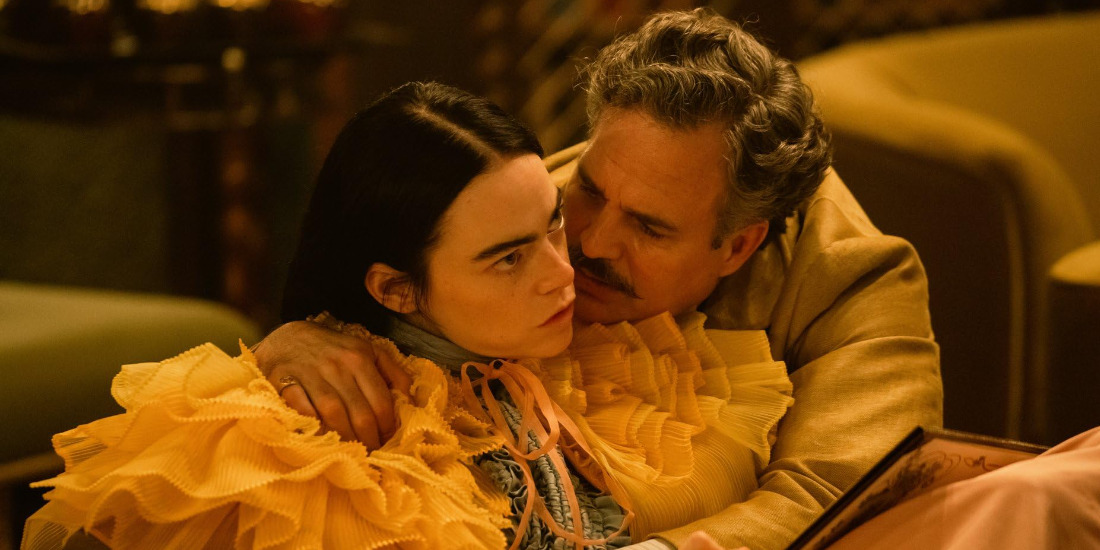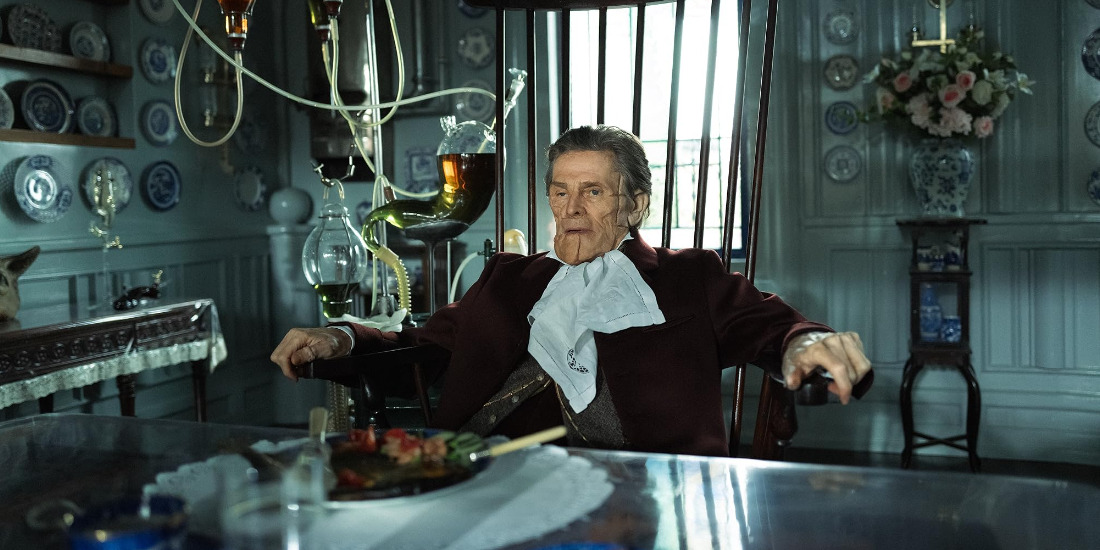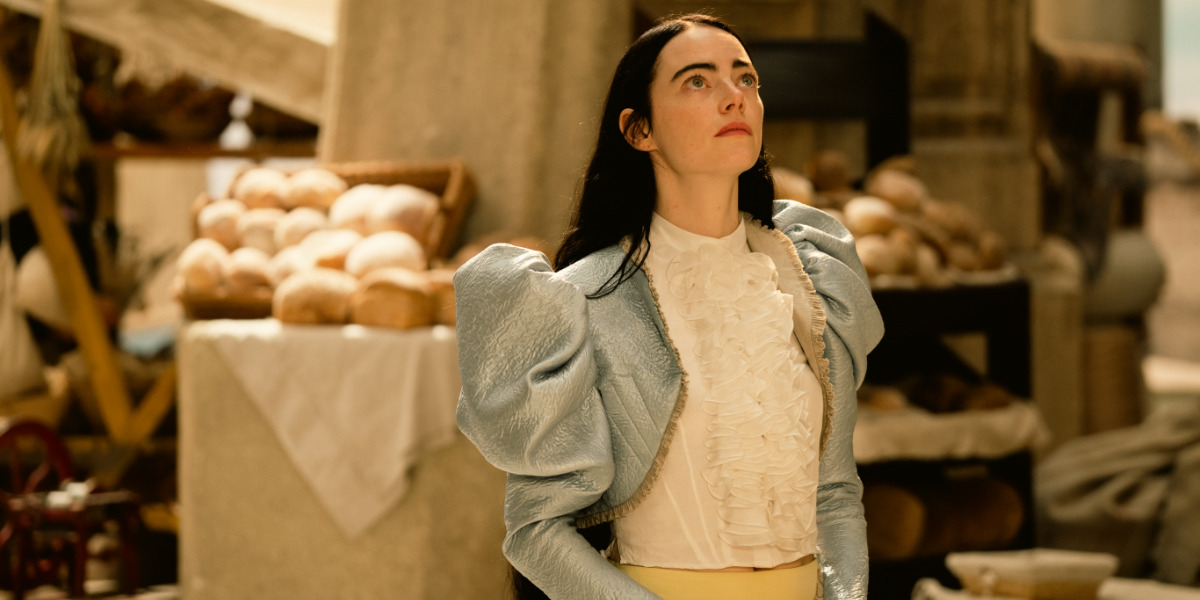Yorgos Lanthimos’ ‘Poor Things’ is a vivid and vibrant journey into a woman’s unabashed exploration of a world seen through a fascinating lens free of society-bred conformity and conventions. Centering around Bella Baxter, a fully-grown woman with the brain of an expeditiously aging newborn, the film follows the girl’s experiences starting from her inception in Dr. Godwin Baxter’s lab. As the woman’s mind expands, it takes her to newfound experiences, her unconventional personality rendering her a magnet for new excitement and troublesome adventure. However, as Bella discovers the world in her joyous journey of intellectual and sexual liberation, she must also face the perplexing side of the human condition.
‘Poor Things’ continues Lanthimos’ storytelling legacy of humanity within eccentricity by presenting a tale about a rambunctious woman set loose on a world that blends Gothicism and Steampunk motifs. Yet the social setting of the story, within the 19th-century Victorian era, shines through in its aesthetic and subliminal socio-politics. Thus, the film easily captures the audience’s curiosity regarding the origins of Godwin Baxter and the way his fascinating experiment goes on to make her mark upon the world.
Poor Things: A Vivacious Adaptation of Alasdair Gray’s Work
‘Poor Things’ is not based on a true story. Instead, it finds its origins in the celebrated eponymous book by Scottish author Alasdair Gray, essaying a similar sci-fi historical fiction tale about an intriguing woman. While the 1992 novel stands as a renowned work of literature on its own, the story in itself also holds roots in classical literature, furthering the compelling foundation of Bella Baxter’s narrative.

Popularly known as a ‘Frankenstein’ retelling, Author Mary Shelley’s influence over Gray’s work remains evident with the latter’s premise of corpse reanimation harvesting direct inspiration from Shelley’s ‘Frankenstein.’ Furthermore, Bella’s adventurous grand tour of the world, which awakens her intellectual and sexual desires by providing her outlets for the same, holds a noticeable parallel to the infamous Creature’s journey. Yet, Gray’s work brings so much new and original substance and nuance that it strays further from a retelling and into a tale of its own with merely discernible literary inspirations.
Comparably, Lanthimos’ interpretation of Gray’s work also ends up building its own fascinating narrative. Still, it strives to remain considerably close to the source material while remaining conscious of the parameters set by a film reel. Thus, while this adaptation holds true to the premise, broader narrative, and spirit of Gray’s work, it also doesn’t shy away from paving its own path as necessary.
The novel employs multiple perspectives by different characters, save for Bella, to provide differing accounts of her adventures. In doing so, it spins an inventive tale that observes gender politics by analyzing the connection between women’s independence and men’s craving for control. Furthermore, the book also delves into class-related politics, reflecting socialist rhetoric.
The film seamlessly hones in on the former political allegory. As such, it examines the feminist expression behind Bella’s story— most brazenly through raising the woman to be the narrator of her own tale. When prompted, Lanthimos described Bella’s story as “a human being that has a chance in the world – someone who hasn’t been molded in a very specific manner to perceive the world in a certain way. She gets to start clean, and that gives her a far freer view of things.”
Meanwhile, Emma Stone, who helms the film as the lead actress and producer, refers to the film as a story about a woman “who doesn’t have to deal with shame.” Both descriptions aptly draw a picture of Bella’s central character and how her lack of ties to the world’s reality for a woman frames her perception of it and her position within it.
Nevertheless, Lanthimos chose to relinquish the more philosophically political aspect of the novel that drew from the real-life political relations between Scotland and England. Speaking about the same, the filmmaker said, “I thought that couldn’t be part of the film, both in terms of just practically making that kind of philosophical essay into a film, but also me being a Greek person, making a film about Scotland. It would have been totally disingenuous of me.”
Lanthimos himself was introduced to Gray’s writing through a friend of his. After reading ‘Poor Things,’ the director was immediately pulled by the narrative and decided to meet with the author as soon as he discovered that the novel hadn’t yet been adapted cinematically. From there, the work began on the script with screenplay writer Tony McNamara, who previously collaborated with Lanthimos on ‘The Favorite.’
Ultimately, Lanthimos’ ‘Poor Things’ came into being, carrying the heavy influence of Gray’s direct base work as well as Shelley’s timeless influences. However, the story holds little ties to reality, impudently satisfied to chart its fantastical, fictional narrative.
Godwin Baxter: More Than an Average Mad Scientist
Given the film’s overall fictionality, Willem Dafoe’s Godwin Baxter also remains confined as a fictional character without any connection to a real doctor. Considering his necromancy-esque practices, the same doesn’t come as much of a surprise. Nevertheless, Godwin’s atypical scientific curiosity and general disposition are bound to dispel a sense of familiarity within the viewers.

Godwin’s depiction in the film as a questing man who evolved from a boy who was once a regular test subject to satisfy his father’s curiosity about human biology seemingly shares a similarity with Victor Frankenstein and his Monster. Moreover, the character shares his first name— Godwin— with Author Shelly’s father, William Godwin. Although the connection between them remains innocuous and unofficial, it may possibly be a reference to establish the intentionality of Godwin Baxter’s resemblance to Frankenstein and the Creature.
Interestingly, Godwin fits into the molds of both Victor and the Creature, consequently rendering Bella a reference to the latter as well. However, where Victor is normally remembered and often adapted as a mad scientist, Baxter follows a slightly different path.
Actor Dafoe shared his similar opinion and distaste for Baxter’s possible mislabeling as a mad scientist by evoking the deep compassion found within his character. “He’s a man that has had a painful past, and rather than dwell on that, he’s tried to turn that into something positive,” said the actor in an interview with Entertainment Weekly. “And so there are interesting parallels to Bella. In fact, they share a similar journey, in a funny way.”
Therefore, despite his similarities to Shelly’s characters— whether it be the creator or his creation— Godwin Baxter mostly stands as his own individual. Without any ties to a real-life doctor or necromancer, Godwin remains a work of fiction.
Read More: What is the Message Behind Poor Things? Is it a Feminist Movie?


You must be logged in to post a comment.